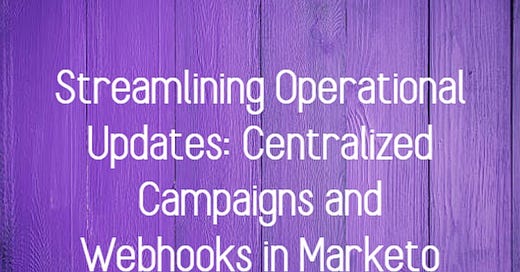In this blog post, let’s explore the advantages of adopting a single central campaign setup for operational updates, emphasizing the importance of managing processes consistently.
Centralized Campaign Setup for Operational Updates
Managing operational updates across various lead gen programs can quickly become a daunting task. Instead of handling individual campaigns for each program, it's advisable to create a single central campaign setup. This approach not only simplifies the process but also enhances the ability to manage updates consistently.
One key example of this streamlined approach is syncing leads to a CRM. By centralizing the management of this process, you eliminate the need to handle it within each separate lead gen program. This centralized setup ensures a more efficient and organized workflow, allowing you to focus on refining your strategies rather than navigating through multiple campaign structures.
Executable Campaigns: Enhancing Campaign Synchronization
In Marketo, Executable Campaigns play a pivotal role in optimizing campaign synchronization. While they are not trigger campaigns themselves, they are designed to be called synchronously by other campaigns. This functionality proves invaluable in reducing arbitrary wait steps within regular campaigns that have interdependent flow steps.
For instance, Executable Campaigns are compatible with trigger campaigns, allowing for a seamless integration of processes. This feature enables marketers to execute campaigns synchronously, ensuring that steps are executed in the correct sequence. The result is a more streamlined and efficient campaign execution.
Compatibility with Trigger Campaigns, Not with Webhooks
It's important to note that Executable Campaigns are compatible with trigger campaigns but not with webhooks. Webhooks need to be run by a trigger campaign, and you determine the completion of a webhook's execution by triggering on "Webhook is Called." - i.e., using this trigger, you can still ensure that flow steps dependent on the webhook execution are run after the webhook call is made and the response is returned
This ensures that your campaign workflows remain organized and that the execution of various processes is well-coordinated.
Tl;DR
Adopting a centralized campaign setup for operational updates is a strategic move toward efficiency and consistency. By leveraging the Executable Campaigns and understanding their compatibility with trigger campaigns, Marketo users can streamline their workflows and ensure that operational updates run seamlessly.
Before you head out, ensure you're in the know about the latest January 2024 product updates! Check out my LinkedIn post for a quick rundown of all the groundbreaking features. Stay up-to-date, stay ahead! 💜





Darshil, thanks for sharing this! I've been in the deep end of executable campaigns and central order of ops for awhile now. Wondering how you prefer to trigger them?
I've been setting them up to be called within a local program. The advantage here is that you can control the timing. Someone fills out a form, update local program fields and prior to syncing to an SFDC Campaign, you call the Executable Campaign.
The issue here is that you cannot be dependent on a webhook. Otherwise, it breaks up the timing. I think the middle ground here is to call the Webhook a-sync from Order of Ops. It nearly always completes in time, but it's not perfect. Would love to hear what you're seeing. :)
Superbly informative article Darshil Sire! 👏 It is so insightful to know about Marketo's Executable Campaigns ✨ So important! Thanks a ton for sharing this 👏🤗